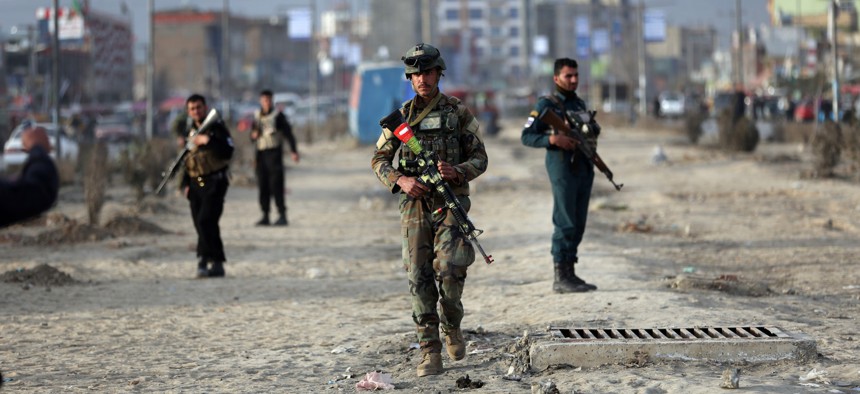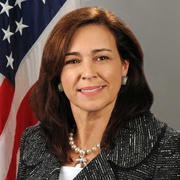
Afghan security personnel gather at the site of bomb explosion in Kabul, Afghanistan, Wednesday, Feb. 26, 2020. AP Photo/Rahmat Gul
Beware a Peace Deal That May Spell War
There are important questions still to be answered about Afghanistan and the United States.
Americans, so we are told, don’t care about foreign policy. Every poll shows it is a low voter priority. But Americans do care about U.S. troops and their ability to safeguard our country, prevent war, and preserve our way of life. That matters.
In that spirit, every American should pay attention to the Friday, Feb. 28, announcement of a peace deal with the Taliban that the Trump administration is expected to sign. It might not create peace.
There are important questions that this administration has not fully answered on this Afghanistan deal, including precisely what a phased reduction of American forces in Afghanistan really means for our long-term security.
The agreement calls for an initial U.S. troop withdrawal over a five-month period from the current 12,000 troops to no more than 8,600. The idea is that Taliban leaders will be able to curb violence, reduce terrorism, and commit to participate in further talks through an “intra-Afghan process.”
The first problem is conditionality. Pentagon officials insist that withdrawals of U.S. forces can only happen if the Taliban leaders do not shelter al Qaeda and other terrorist players operating on Afghan territory. According to senior U.S. officials, the job of verifying the Taliban’s word falls to Gen. Scott Miller, the senior commander of forces in Afghanistan. But there is little in the way of metrics and measurements to ensure that judgement call is sound. And, back in Washington, there is concern that President Trump will be the actual decider-in-chief, rather than Miller or Pentagon leaders, and that he will give more priority to his own politics than Americans’ security.
Verification may come down to intelligence. But whom should Americans trust? Even in a world of technology, human intelligence still matters especially in monitoring a peace agreement. With a commander-in-chief who rejects intelligence findings it may be hard to know what is happening on the ground in Afghanistan. We need a more comprehensive way to know if the Taliban are truly complying or just buying time to regroup. Verification and compliance have not been fully spelled out, and it is not clear which of the many terrorist groups in and around Afghanistan will be monitored, including ISIS and the Haqqani network. Earlier estimates of terrorist groups in Afghanistan suggest there are as many as 20 to monitor. Additionally, the Taliban negotiated for the release of its prisoners; we will need to know where they go and what they do. Violence reduction sounds good if we know the agreed definition and benchmarks of it across Afghanistan, a sprawling nation.
Related: Will Trump’s Afghanistan Peace Deal Win Him Votes?
Related: Who Gets to Tell the Story of the Afghanistan War?
Second, this agreement requires an in-depth understanding of the complexities of internal Afghan politics—not something that Trump seems interested in. The deal presupposes that there is an Afghan government to sit across from the Taliban in so-called “intra Afghan” process. To accomplish that requires strong players. The Afghan government is divided and dysfunctional — hardly in a position to do its part steering a national reconciliation. The election in Afghanistan gave the victory to incumbent President Ashraf Ghani but his rival, Abdullah Abdullah, has refused to recognize the results. Afghan warlords are divided, the security situation is tense, and the Taliban have rejected the legitimacy of the Kabul government. And the Taliban is divided.
Third is the question of what U.S. remaining forces can accomplish for themselves and Afghans—especially if Trump’s true agenda is a drawdown to absolute zero. It is hard to see how American soldiers reducing their footprint can continue to patrol, protect, and train Afghans. With a divided Congress, there might be little support in Washington for continuing the training mission in a country devoid of American troops to do it. If the administration is serious about its counterterrorism agenda, it needs force to back that up. It is hard enough to stop terrorism within Afghanistan now. Launching special operations and countering violent attacks with fewer supporting troops also could prove difficult and subjects our forces to higher risk. A reduced American footprint also signals to our NATO allies’ capitals that it is safe to withdraw. And once the troops are gone, we can’t influence anything in Afghanistan. If all that is left in Afghanistan is an embassy, those diplomats will be vulnerable. In the interim, an isolated America will have less sway in the European talks with the Taliban.
It is always possible that Trump simply will order all 12,000 U.S. forces home without an orderly process, as he did in Syria. As far back as summer 2017, the president told advisers that he wanted all troops out of Afghanistan by November 2020 suggesting that the terms matter less than his reelection. That is a deadline, not a process. It is exactly the kind of timeline-based pullout Republicans (especially) have opposed for years. He has also reportedly vented against the costs of the U.S. embassy in Kabul. Cutting diplomacy is a mantra of this president. A shrunken diplomatic presence in Kabul could further limit our ability to monitor the peace.
A big peace agreement without force nor diplomacy will be hard to execute and American credibility will be sacrificed. There are already rumors in Washington among the foreign policy watchers that the U.S. role in Oslo where negotiations will happen could be minimal. We could be bystanders to the whole final chapter.
For nearly two decades we invested in Afghanistan and lost 2,400 lives doing it — and 150,000 Afghans died. Leaving a mess behind will leave many wondering what we gained, more than they already do. And if we end up with a major terrorist attack traced to the Taliban we will regret not having capabilities beyond drone strikes and symbolic responses.
Peace deals always sound good on paper. A reduction of troops in Afghanistan also sounds good since most Americans — and most of the 2020 presidential candidates — feel that we have gotten too bogged down in “endless wars.” But at the end of the day, we must be safe and secure in a dangerous world.
We all want peace. But it has to be real peace, not a run for cover. And it has to be managed by good leaders here and overseas. Congress and the American public should ask hard questions. There are many.
NEXT STORY: Trump Freezes Hiring at Another DHS Agency




